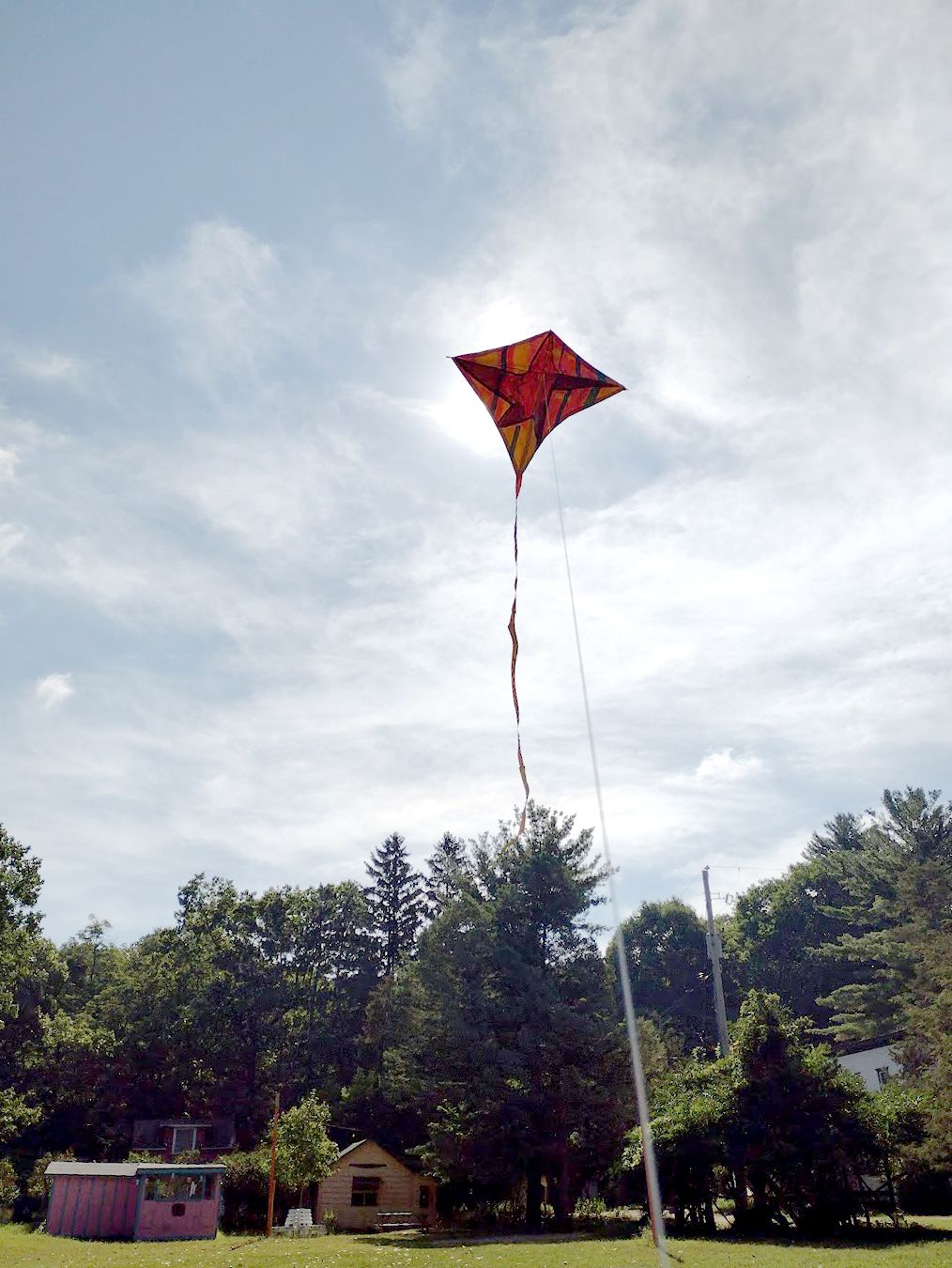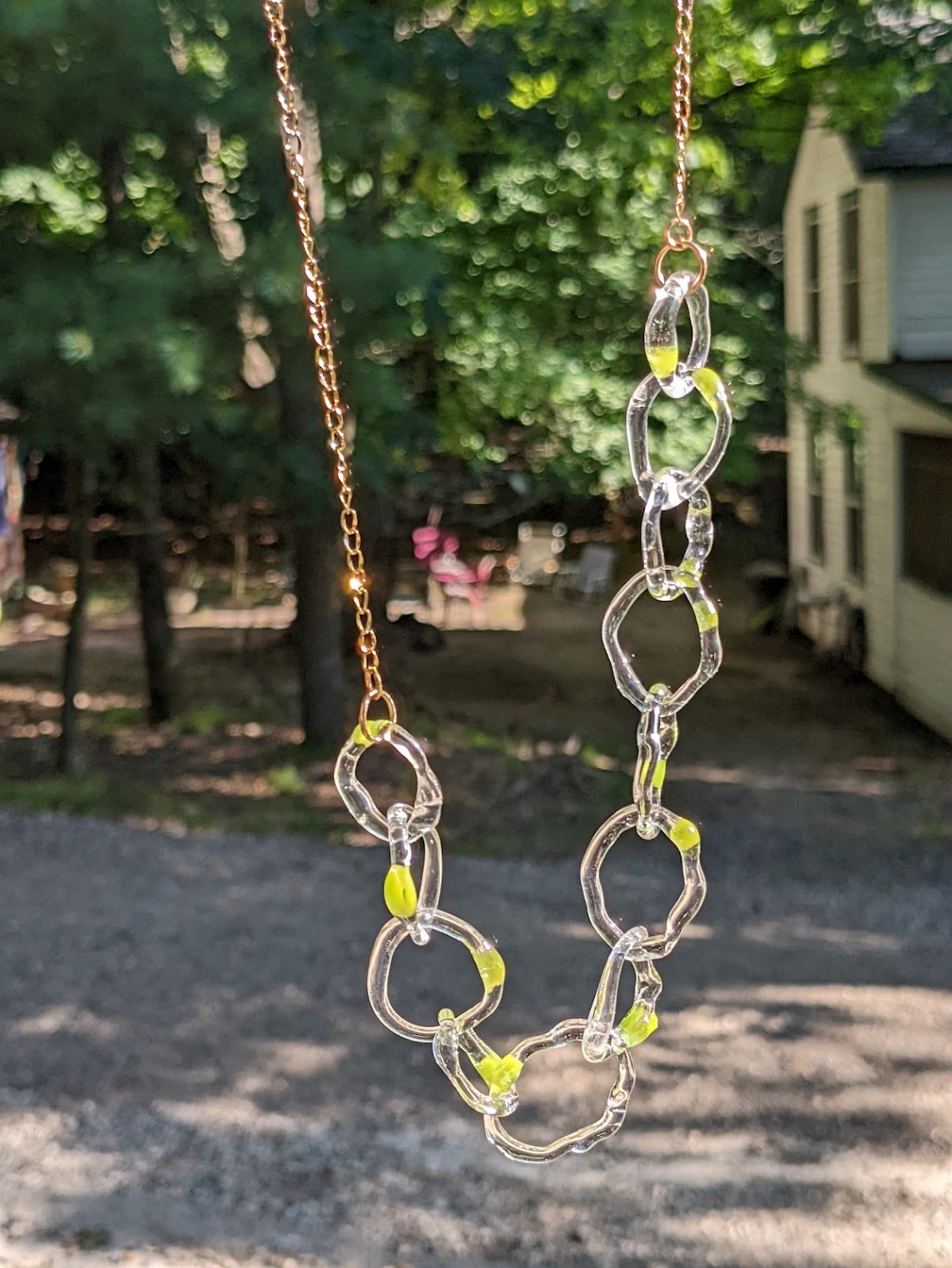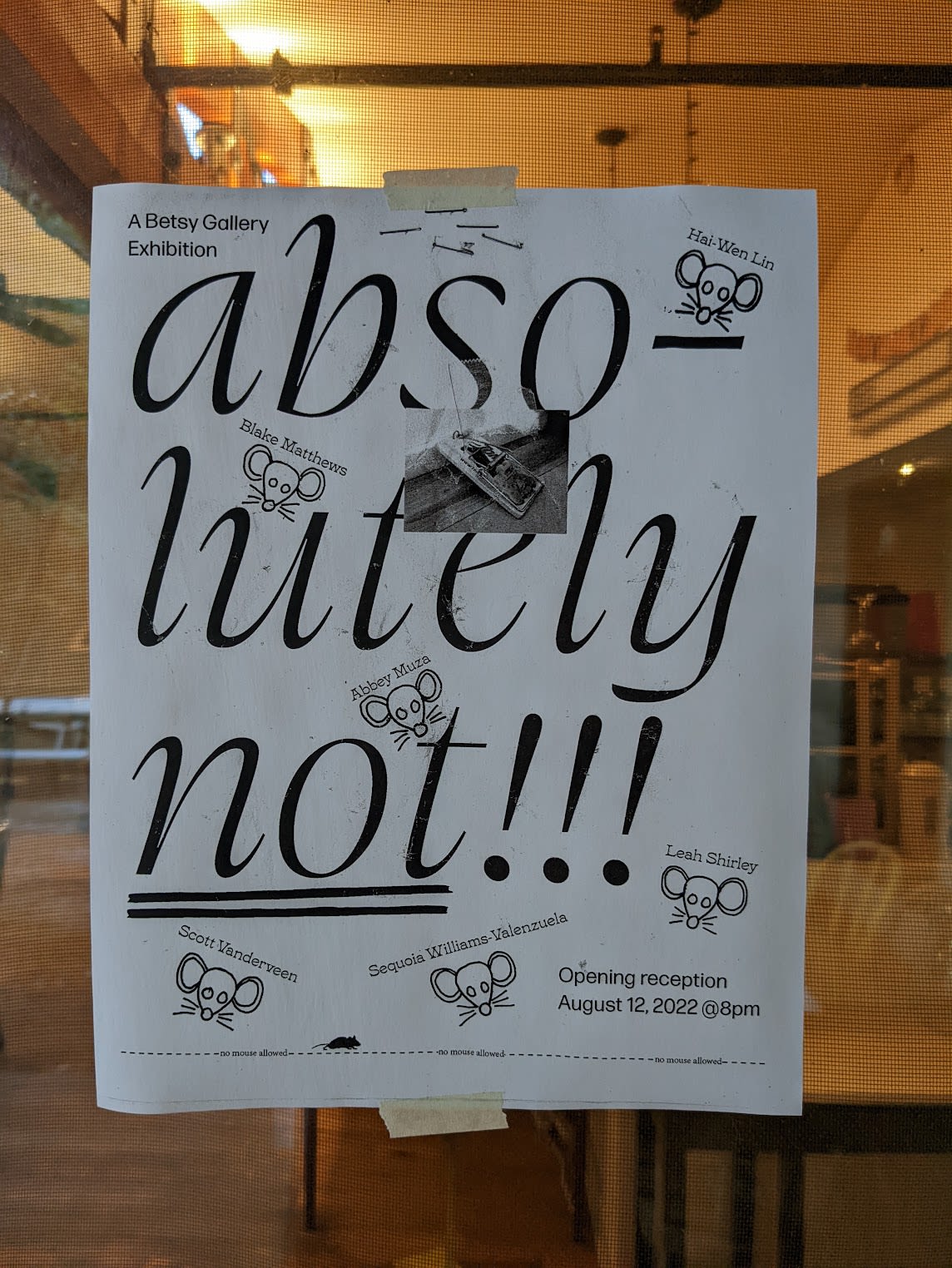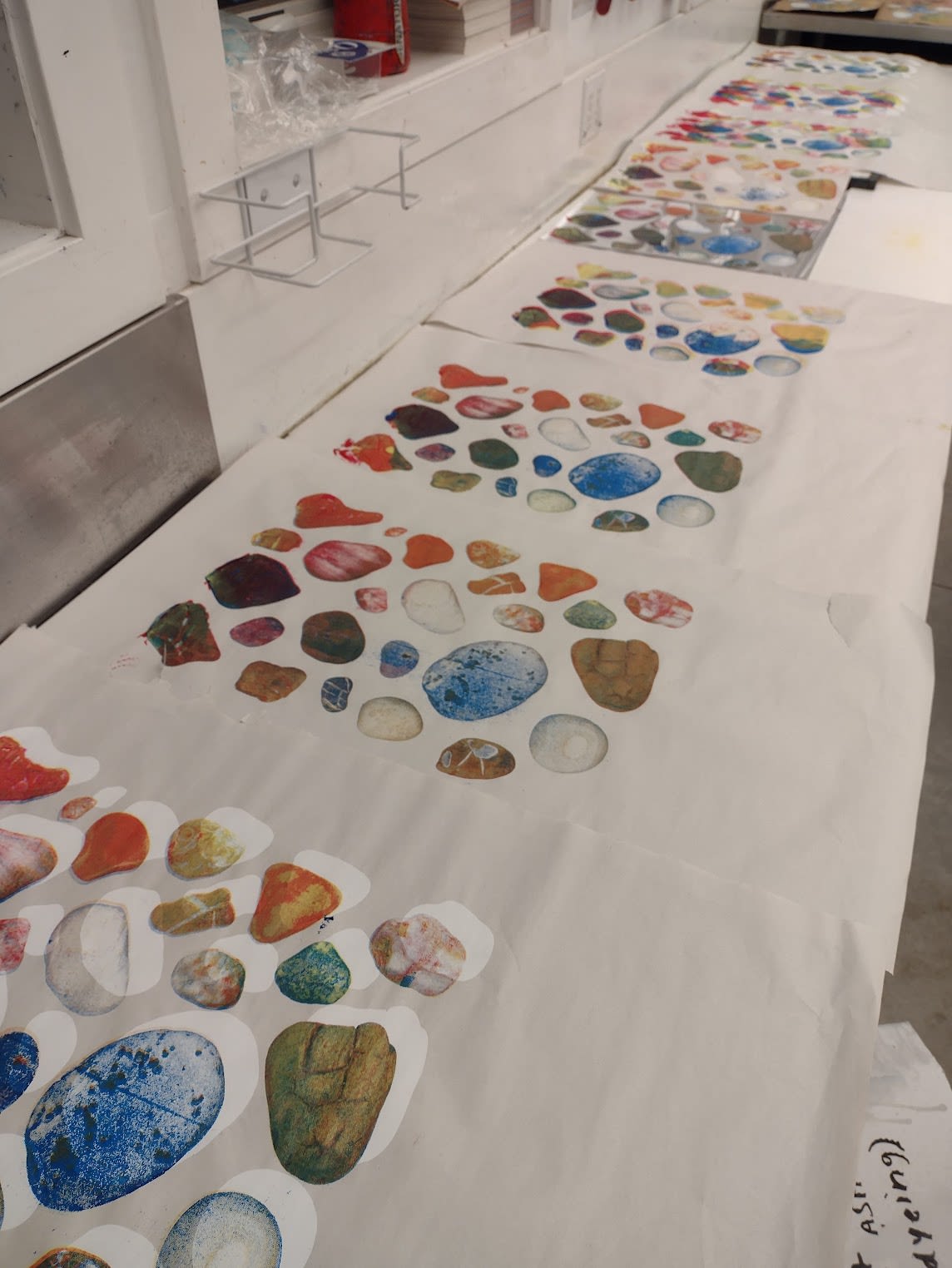Student Hai-Wen Lin Cultivates the Art of Living at Ox-Bow
The first kite that Hai-Wen Lin made with fellow Ox-Bow fellow Scott Vanderveen. Image courtesy of Hai-Wen Lin
The first kite that Hai-Wen Lin made with fellow Ox-Bow fellow Scott Vanderveen. Image courtesy of Hai-Wen Lin
by Sophie Lucido Johnson (MFA 2017)
When Hai-Wen Lin (MDes 2023) arrived at Ox-Bow, where they had been awarded the LeRoy Neiman Summer Fellowship, they weren’t immediately sure what to do with themselves.
So they started with material language that felt familiar: whittling sticks and making nets. Then, because Lin is a kite-maker, they turned their whittled sticks into a kite frame. The kite needed a face, so Lin got a bunch of brown paper and asked one of the other fellows, Scott Vanderveen, to paint it, marking Lin’s first collaboration. Together, they flew their kite outside, at the edge of the Tallmadge Woods overlooking Ox-Bow Lagoon in Michigan.
Once Lin had experienced the taste of collaboration, they wanted to do more; they started to dabble in all that Ox-Bow had to offer. “I tried to weasel my way into every single studio facility,” they said.
This type of artistic exploration is exactly what Ox-Bow School of Art is for. The summer school and artists residency space is more than just a physical location: it’s an experience. Ox-Bow aims to offer opportunities for artists at all stages in their career. The 115-acre campus, which is a separate school from the School of the Art Institute of Chicago (SAIC), features both credit- and non-credit-bearing courses, work scholarships, and remote studio spaces. Lin was perfectly situated to take advantage of its network of creative resources.
A glass necklace Hai-Wen Lin created using the facilities at Ox-Bow. Image courtesy of Hai-Wen Lin
A glass necklace Hai-Wen Lin created using the facilities at Ox-Bow. Image courtesy of Hai-Wen Lin
Lin makes kites. At least, that’s what they tell people when asked about their art practice. But, of course, it’s so much more than that: Lin is in the Fashion Design program at SAIC and is currently working on their senior thesis: a wearable kite and an instrument played by the wind.
“I would say that my work is about attuning myself to the environment and building performative or sculptural objects that help facilitate that,” they said. “But I think the broadest picture of my practice is really about just being present in life. It’s about breathing, walking, and finding a sense of freedom.”
That artistic philosophy made Ox-Bow the perfect atmosphere for Lin. They learned to screen print on the premises and screen printed rocks that they’d collected on the beach with Devin Balara, the manager of the metal studio. From that relationship, Lin started sitting in on metal studio lessons, and learned how to inflate metal, so they could make a buoy to float on the lake.
“Then I talked to Dove [Hornbuckle], the ceramics studio manager, who helped teach me the basics of ceramics. I ended up making a wind chime,” Lin said. They even got to try out flame-working in the glass studio. At the end of their multi-week stay, Lin had taken on dozens of art forms, experimenting and playing, learning skills while building relationships.
Lin collaborated with the other fellows—there were six in all—on an end-of-summer gallery show. Fellows were granted studio space in exchange for working on the grounds. Lin was responsible for taking promotional photographs for Ox-Bow; others set up classrooms or cleaned. The show they put together was called Absolutely Not!!!.
The final poster for the Ox-Bow exhibition put together by the fellows. Image courtesy of Hai-Wen Lin
The final poster for the Ox-Bow exhibition put together by the fellows. Image courtesy of Hai-Wen Lin
“The reason it was called that was because there was one week where there was a mouse running in and out of our rooms,” Lin said, laughing at the memory. “Scott wrote a sign at the edge of his door that said, ‘No mouse allowed; absolutely not.’ That phrasing was the impetus for the titling and framing of the show about our shared experience.”
Lin took it one step further, developing a parallel show held by the mice, composed of miniature fine arts prints featuring mice, installed at mouse-height. “Scott bought mechanical mice that are activated when you bumped into them, and they were just scurrying around the perimeter of the room during the opening,” Lin said.
This levity was central to Lin’s experience at Ox-Bow: the opportunity for collaboration and playfulness. There were parties on Friday nights, and long stretches of freedom during the day. Lin and other fellows often took canoes out to a nearby beach to talk, rest, and contemplate.
“I'm definitely somebody that likes to keep to myself a little bit more. There's a part of me that feels like I don’t quite fit in. But it was just such a fun and accommodating space where it really felt like I could be who I want or I could be myself and I could do really anything,” Lin said.
Some samples of rock screen prints Hai-Wen Lin experimented with at Ox-Bow. Image courtesy of Hai-Wen Lin
Some samples of rock screen prints Hai-Wen Lin experimented with at Ox-Bow. Image courtesy of Hai-Wen Lin
For Lin, art practice is synonymous with life practice. They are cultivating presence in activities like walking and cooking—even (or maybe especially), as Lin put it, “thanking.” Although Lin has engaged in lots of different art forms—bookmaking, sculpting, performing—they’ve recently wanted to shift the focus to slowing down and showing what it looks like to live a simple life. They love to perform gratitude as a part of their practice—to tell and show the people in their lives that they’re thankful for them.
Ox-Bow gave Lin the opportunity to cultivate the kind of attention, time, and space that is essential for a lived practice. They expressed gratitude for the opportunity to wake up and not have to think about what you’re going to wear or eat; where nature is abundant and a community of artistic thinkers is always a stone’s throw away.
{{[http://www.saic.edu/news/students]STUDENTS}} {{[http://www.saic.edu/news/artconnectsus]ART CONNECTS US}}




